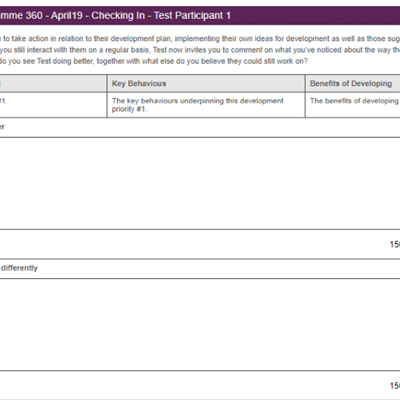In this final blog of the series, we want to remind you what to do once your 360 feedback process has been completed, how to evaluate and align on next steps in order to keep the 360 feedback cycle running.
To summarise the steps we’ve taken so far, the 360 feedback process includes:
- Measuring the right skills, relying on empirical research to determine which leadership competencies really make a difference to the performance of staff in the organisation, rather than on some senior executive’s beliefs about what makes a good manager.
- Taking the time to properly explain, both to participants and to the people giving feedback to those participants (we call them ‘raters’), why they’re going through the exercise and how the data will be used for the participant’s development.
- Making it known that there will be no breaches of confidentiality, thereby encouraging raters to speak their truth.
- Where necessary, creating a bespoke 360 questionnaire that requires just 15 to 20 minutes to complete, to avoid questionnaire fatigue.
- Primarily focusing on discovering strengths - and leveraging those strengths - rather than using the process to uncover deficiencies.
- Tailoring the results and 360 feedback report to each individual and to his or her position.
- Presenting each person’s results in a way that enables them to digest those results constructively and using the data to create a personal plan of development.
- Reviewing the action plan and turning the outcomes into actions.
Evaluating Your 360 Feedback
Once you’ve completed all of the above steps, it's important to evaluate the entire process and compare progress a few months on. You should ask what raters have noticed some months after an initial 360 report.
What we have observed over the last 20 years of running 360 degree feedback projects is how few participants actually repeat the 360 process and turn it into a feedback cycle. These findings emerged in a research study conducted by click-360SelfDrive a few years ago. Survey participants were HR, OD and L&D Directors and Managers in 49 large UK organisations collectively employing approximately 410,000 people. Less than 10% of 360 feedback participants received a repeat 360 within 18 months of the original.
This is a hugely missed opportunity. There are two types of feedback loops in business: negative feedback loops and positive feedback loops. They are both used to draw attention to significant issues within the company and create long-term solutions. Feedback cycles help teams to be more coordinated, collaborative, and committed to their roles and career progression. They can also encourage more proactive and shared ownership within the team, improved team performance, and agility.
360 Feedback Cycles
The main reasons for the lack of repeat 360 feedback sessions most often comes down to cost. Not so much the financial cost of running a 360 programme, but more the cost in terms of time and effort expended in completing another 360 feedback implementation in organisations where people are already stretched.
This is why click-360SelfDrive introduced the concept of ‘checking in’, highlighting the importance of creating a feedback cycle. ‘Checking in’ is a process which kicks in some months following the original 360 report, whereby the participant reminds their raters what their key development priorities were and then asks what the raters have noticed. It may feel like you are repeating the 360 feedback process, but it is important to evaluate how far you have come during this time
At first we used to do this in the physical world, and that still happens in some of our model implementations, but more recently – with the advent of the digital report and integrated workbook – we can now offer this process electronically.
The two key questions to ask in respect of each development priority are:
- “What have you noticed me doing better?”
- “What do I still need to do differently in order to progress?”
It is also useful to ask a final catch-all question at the end: “What other development priority(ies) should I also be working on?”


Scheduling The Check-In Process
The checking in process can be enabled during survey set-up and the date range selected from a drop-down menu that runs from 30 days up to 540 days following the original 360.
Alternatively, the checking in process can be kick-started manually at any time following the initial implementation. A recent enhancement allows the participant to modify their rater network before the invites go out, in case some of the original raters have left and new ones joined.
By using the checking in process some months after an original 360 degree feedback implementation, participants get a sense of whether their leadership or management capability is actually improving. At the same time, the organisation that employs them gets to see an objective return on their investment, albeit a cultural impact rather than necessarily a financial one.
At click-360SelfDrive, we support a range of organisations in their 360 feedback processes. If your organisation is interested in the 360 feedback process, kick starting the checking in process, or just general feedback support, please don’t hesitate to get in touch or sign up to a free trial.